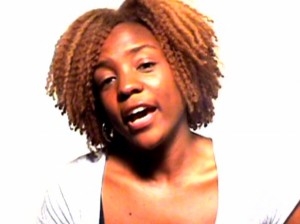The Washington Post
The State of Black Art
Folk video artist Jefferson Pinder seeks to cast off ‘black art’ label
By Blake Gopnik
Sunday, January 24, 2010
Jefferson Pinder stands in the Jacob Lawrence room at the Phillips Collection, studying the great “Migration” series Lawrence painted in 1941. Watching Pinder look, you realize how much has changed in black art since then, and how little.
Pinder, a 39-year-old born, raised and still working in Washington, is a highly trained art professional, one of the best in the city. He uses video to craft sophisticated postmodern statements about race in the 21st century. Lawrence, without access to a lot of formal education, had to pioneer a way to bring black subjects up to speed with art’s new modernist trends. Taking in Lawrence’s work, Pinder says he is impressed by how “it doesn’t try to be more than it is.”
He thinks of this as his goal, too. “I see myself as a folk video artist,” he says — someone who, in a world of million-dollar music videos, more or less just sets a situation up, points the camera and shoots. “I don’t know if I can speak to all of experience — but I can speak about what I know.”
So far, Pinder has spoken about the racial burdens every black man still carries — via a video called “Mule” that documents Pinder himself, in suit and tie, dragging a 300- pound log through inner-city streets. Another statement, conveyed in a looped video called “Fisticuffs,” is about the inevitability of racial conflict: Two men, one black, one white, tussle in a landscape forever. And there’s a statement borrowed from Ralph Ellison’s “Invisible Man”: A video shows Pinder standing in a basement room that’s hung with 1,369 light bulbs, as per the famous description in Ellison’s book. More and more of those bulbs turn on, until Pinder disappears in a glare of whiteness. (This work won Pinder a spot in the important “Frequency” show at the Studio Museum in Harlem in 2006, and then in the stable of Annie Gawlak, one of Washington’s best dealers.)
We’re down in the Phillips cafe now, taking care of biographical details. Pinder is elegant, gracious and trim — he’s spent time in the Marine reserves. An almost-shaved head, cropped beard and mustache top a wide-lapelled blue-suede jacket, circa 1973, that reveals an army-green shirt and narrow tie.
“I’m grounded in this area,” Pinder says. “My family goes back a long way.” He was raised in Silver Spring, where he once again lives, by a father who wrote speeches for D.C. Health and Human Services and a mother who taught school.
A much older sister took him around to Washington’s museums — which turned out not to be enough to launch his career as an artist. As a teenager, Pinder says, he had “a hard time believing you could make art and it would be taken seriously.” Instead, he followed up another longtime interest, the theater, and went to the University of Maryland to study that. (He’s back at his alma mater now, as an assistant professor in its art department.)

For his video compilation, the artist asked black Washingtonians to lip-sync tunes that seemed to belong to the opposite race. These selections feature Nekisha Durrett doing “Little Red Shoes” by Loretta Lynn and Pinder himself mouthing the words to “Space Oddity” by David Bowie.
Pinder then had a stint doing good works in Seattle, accompanied by the woman who is now his ex-wife. They lasted four years there — had a son, who now lives near Pinder in Silver Spring — then headed back to D.C., where Pinder got a master’s in fine arts at the University of Maryland.
The artist says he can’t seem to fight the “black art” label, and the “ghettoization” it brings. So should Pinder go with blackness as subject matter — it’s what he knows — or figure out “how to break out of those restrictions, at the same time being aware that society is more comfortable having you in a particular place”? Pinder says his Marine Corps training helped him arrive at a strategy. In the Corps, he learned that the only way to survive an ambush is to “fight in the direction of the fire.”
His video compilation called “Juke” may represent his best counter-assault yet. Struck by how self-conscious he always felt to have “white” music playing in his car as he approached the inner city (“it was threatening to my blackness”), he decided to make a video in which black Washingtonians lip-sync tunes that seemed to belong to the majority race. In one segment of “Juke,” the African American painter Nekisha Durrett does a stunning rendition of “Little Red Shoes,” Loretta Lynn’s white-trash ballad. In another a young black man — Pinder himself — sings “Space Oddity” by David Bowie.
Like all Pinder’s best videos, it is a simple conceit, simply realized. But it speaks simply of the same complexities that Jacob Lawrence did.